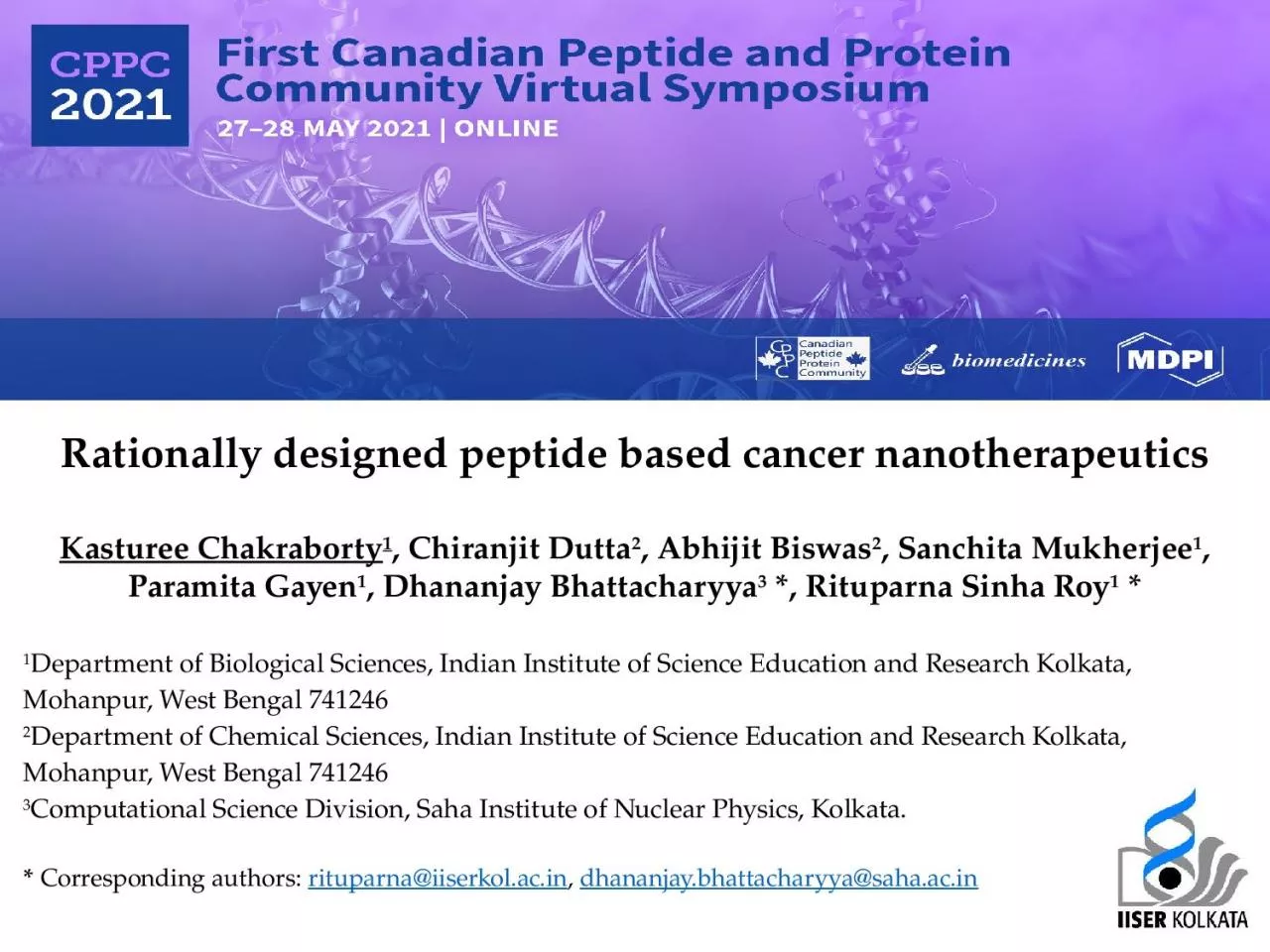

Kasturee Chakraborty 1 Chiranjit Dutta 2 Abhijit Biswas 2 Sanchita Mukherjee 1 Paramita Gayen 1 Dhananjay Bhattacharyya 3 Rituparna Sinha Roy 1 1 Department of Biological Sciences Indian Institute of Science Education and Research Kolkata ID: 917614
Download Presentation The PPT/PDF document "Rationally designed peptide based cancer..." is the property of its rightful owner. Permission is granted to download and print the materials on this web site for personal, non-commercial use only, and to display it on your personal computer provided you do not modify the materials and that you retain all copyright notices contained in the materials. By downloading content from our website, you accept the terms of this agreement.
Slide1
Rationally designed peptide based cancer nanotherapeutics Kasturee Chakraborty1, Chiranjit Dutta2, Abhijit Biswas2, Sanchita Mukherjee1, Paramita Gayen1, Dhananjay Bhattacharyya3 *, Rituparna Sinha Roy1 *1Department of Biological Sciences, Indian Institute of Science Education and Research Kolkata, Mohanpur, West Bengal 7412462Department of Chemical Sciences, Indian Institute of Science Education and Research Kolkata, Mohanpur, West Bengal 7412463Computational Science Division, Saha Institute of Nuclear Physics, Kolkata. * Corresponding authors: rituparna@iiserkol.ac.in, dhananjay.bhattacharyya@saha.ac.in
1
Slide2Abstract: Harnessing self-assembled peptides for generating nanostructured material posses a great promise in delivering toxic conventional small molecule drugs and nucleic acid based biopharmaceuticals for developing cancer nanotherapeutics. Clinically safe intracellular delivery of cargo in functional form remains a major concern for the pharmaceutical industries. We aim to engineer peptide based therapeutics for intracellular functional drug delivery and developing combination therapy for breast cancer treatment. We have evaluated gramicidin (gA) and gA-inspired hydrophobic peptide (LD8) for delivering doxorubicin (Dox) and TAT-peptide inspired arginine-rich cell penetrating peptides for intracellular delivery of functional siRNA to silence critical oncogenic pathways. Both gA and LD8 induce cytotoxicity, mitochondrial depolarization and apoptosis against MDA-MB-231. Doxorubicin loaded LD8 (LD8-Dox-NP) and doxorubicin loaded gA (gA-Dox-NP) showed cytotoxicity and apoptosis, evidenced by DNA fragmentation and Western blot analysis of PARP cleavage and upregulated tumor suppressor protein p53, that inhibits cell proliferation. gA-Dox-NP and LD8-Dox-NP induce S and G2 phase cell cycle arrest, respectively, indicating inhibition of DNA synthesis by gA-Dox-NP and DNA damage in presence of LD8-Dox-NP. gA-Dox-NP and LD8-Dox-NP can be potentially used as 2-in-1 nanomedicine in treating breast cancer. Our designed arginine-rich molecular transporters demonstrated functional siRNA delivery in MDA-MB-231 cell line like commercial transfection agent HiPerFect and showed significant gene silencing in upregulated MAPK/ERK signaling pathway in breast cancer, evidenced by RT-PCR and immunofluorescence studies and therefore can be potentially translated into clinics. Keywords: Peptide, gramicidin, LD8, molecular transporter2Rationally designed peptide based cancer nanotherapeutics
Slide3Nanoparticles (NPs) can extravasate into the tumors through the gaps between endothelial cells and accumulate there due to poor lymphatic drainageHow cancer can be targeted via nanotherapy…Passive targeting
Enhanced permeability and retention effect (EPR effect)
Active targeting
Davis
et al.
Nature Reviews Drug Discovery 7, 771–782(2008)
Slide4Our Work on peptide as drug or drug delivery
Peptide based cancer nanotheraputics
Gramicidin-inspired peptides as 2-in-1 nanomedicine
TAT peptide inspired stabilized peptides for siRNA-based nanotherapeutics
4
Slide5Gramicidin-inspired molecular transporters having alternating L and D-amino acids Can we use membrane active peptides/ionophore-inspired peptides as cytotoxic drugs or molecular transporter for cytotoxic drugs? We examined gramicidin (gA) and gramicidin-inspired peptide LD8.Designed gramicidin inspired alternating L,D- peptidesChiranjit DuttaLD8 (Boc-LAla-DVal-LLeu-DAla-LVal-DAla-LLeu-DTrp-Ome)gA (HCO-LVal-Gly-LAla-DLeu-LAla-DVal-LVal-DVal-LTrp-DLeu-LTrp-DLeu-LTrp-DLeu-LTrp-NHCH2
CH2OH)
5
Slide6Biological activity of ionophore inspired peptides and their drug loading efficiencyLD8 acts as slow-acting drugMitochondrial Transmembrane potential assay after 48h MTT assay in MDA-MB-231Chakraborty K et al. (Adv. Therap. 2018)Dox onlygA-Dox
-NP
LD8-Dox-NP
3 h
6 h
12 h
Lesser toxicity of LD8 makes LD8-Dox-NP a safer intracellular delivery vehicle for Dox
6
Slide7Biological study of drug loaded nanoparticlesVehiclegA-Dox-NPLD8-Dox-NPPARPβ-ActinDNA damage study Dox loaded LD8 and Dox loaded gA show different mechanisms of cell death.Chakraborty K et al. (Adv. Therap. 2018)
MTT assay of
Dox
loaded peptide 72h
7
Slide8Major findingsChakraborty, K., et al. (2018) Engineering Ionophore Gramicidin-Inspired Self-Assembled Peptides for Drug Delivery and Cancer Nanotherapeutics. Advanced Therapeutics, 1(7), 1800018. (Selected for cover page)8
Slide9High molecular weight and polyanionic natureCannot cross cell membraneRNase susceptibility9Major Challenges in siRNA TherapyProf. Andrew FireProf. Craig C. Mello Our Key ObjectiveEngineer short peptide based clinically safe and efficient siRNA delivery system for cytosolic delivery of functional siRNA
Slide10Multiparametric approach to engineer facial lipopeptide as siRNA transporter
Hydrophobic face facilitates cellular internalization
Peptide
Interaction site with siRNA
Peptide
Sidechain modification by stearyl moiety to facilitate membrane permeation
Arg residues help in interaction with siRNA
Arg-
L/D
His-Arg backbone
Saturated/unsaturated
fatty acid
Fluorophore
Linker
10
Chiranjit
Dutta
Abhijit
Biswas
Slide11Physiochemical characterization of peptide-siRNA complexBiswas et al. (ACS Appl. Mater. Interfaces. 11, 4719-4736 )A net positive charge is required for cellular internalizationMolar ratio (MR) 100 shows complete siRNA maskingAll experiments are performed in MR 10011Dr. Sanchita Mukherjee
Prof. Dhananjay Bhattacharyya
(SINP)
Slide12Biswas et al. (ACS Appl. Mater. Interfaces. 11, 4719-4736 )Peptide uptakesiRNA uptakePeptides are non toxic, stable in serum and RNase and shows significantly higher siRNA than HiPerFect Biological characterization of peptide-siRNA complex
12
Slide13Gene knockdown due to release of functional siRNADesigned peptide 6 showed comparable knockdown efficiency like HiPerFectFITC+TRITC mergedTRITCFITC
Peptide 6_Erk1/2 siRNA
VehicleReal Time PCR
Immunofluorescence
Biswas
et al
. (
ACS Appl. Mater. Interfaces.
11, 4719-4736
)
13
Slide14Major findingsBiswas, A., Chakraborty, K., et al. (2019) Engineered Histidine-Enriched Facial Lipopeptides for Enhanced Intracellular Delivery of Functional siRNA to Triple Negative Breast Cancer Cells.ACS applied materials & interfaces. . 11, 4719-4736. (equal contribution)Arg-Xxx-Arg sequence is more effective than oligoArg sequenceProtease stability of peptides also provides stability to the siRNALess toxicSerum stabilityHigh transfection efficiency compared to HiPerFectCost effective14
Slide1515AcknowledgmentsDr. Rituparna Sinha Roy (Ph.D. supervisor)Prof. Dhananjay Bhattacharyya (collaborator)My lab matesDr. Chiranjit DuttaDr. Abhijit BiswasDr. Sanchita MukherjeeParamita GayenArgha Mario MallickSomnath JanTHANK YOU
Slide1616
Slide1717Peptide code no.SequencesPeptide 1FAM-γAbu-Arg-Gly-Arg-DHis-Arg-DHis-Arg-Gly-Arg-DHis-Arg-NH2Peptide 2FAM-γAbu-Arg-Lys(stearyl)-Arg-DHis-Arg-DHis-Arg-Gly-Arg-DHis-Arg-NH2Peptide 3FAM-γAbu-Arg-Lys(stearyl)-Arg-DHis-Arg-DHis-Arg-Lys(stearyl)-Arg-DHis-Arg-NH2
Peptide 4
c[-Arg-DHis-Arg-
D
His-Arg-Lys(CH
3
CO)-Arg-
D
His-Arg-
D
His-Arg-Glu-]-Lys(FAM)-NH
2
Peptide 5
c[-Arg-
D
His-Arg-
D
His-Arg-
Lys(Lys(stearyl)
2
)
-Arg-
D
His-Arg-
DHis-Arg-Glu-]-Lys(FAM)-NH2
Peptide 6
c[-Arg-
D
His-Arg-
D
His-Arg-Lys(Lys(linoleyl)
2
)-Arg-
D
His-Arg-
D
His-Arg-Glu-]-Lys(FAM)-NH
2
Peptide 7
c[-Arg-
L
His-Arg-
L
His-Arg-Lys(Lys(stearyl)
2
)-Arg-
L
His-Arg-
L
His-Arg-Glu-]-Lys(FAM)-NH
2
Cyc R9
c[-Arg-Arg-Arg-Arg-Arg-Arg-Arg-Arg-Arg-Glu-]-Lys(FAM)-NH
2
Designed peptide sequences